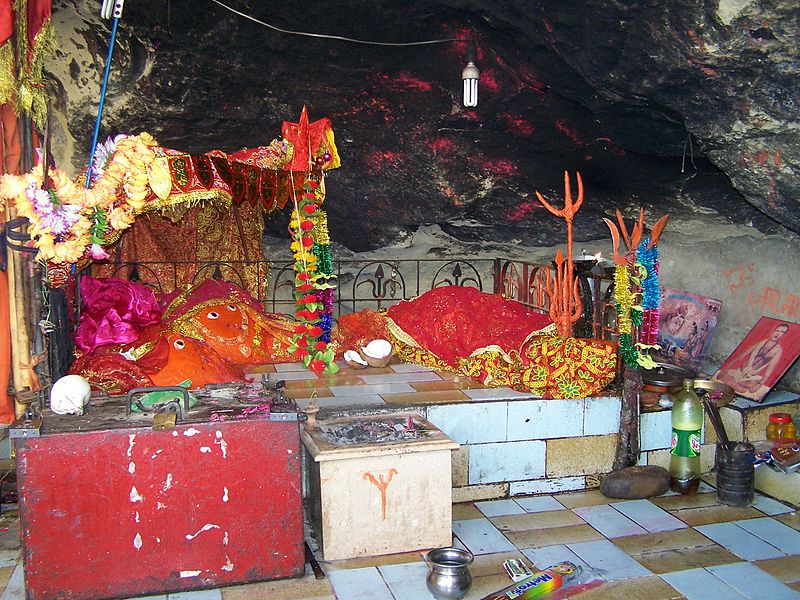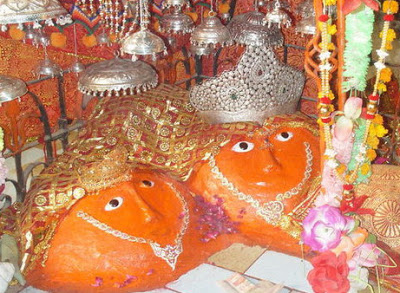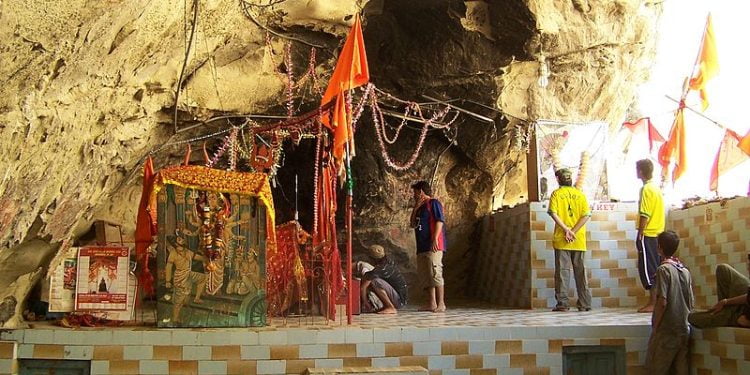The Hinglaj Mata, also referred to as Hinglaj Devi, Hingula Devi, and Nani Mandir, is an ancient Hindu temple situated in the town of Hinglaj on the Makran coast of Balochistan, Pakistan. The temple is positioned in the middle of the Hingol National Park and is considered one of the significant Shakti Peethas of the goddess Sati. This revered site is a manifestation of the powerful Durga or Devi, and it is nestled in a mountain cave by the Hingol River. It carries great historical and cultural significance and attracts devotees from all over the world who come to pay their respects and seek blessings.
Shrine’s History
The Hingol Shakti Peeth holds a revered position in Hindu mythology owing to its association with Sati, whose head is believed to have fallen at this site. Additionally, this Shakti Peeth is considered the foremost among all such shrines, as mentioned in the ancient texts of Durga Saptshati and Markand puran. Various intriguing mythological tales are linked to this sacred pilgrimage site, further elevating its significance in the minds of devotees.

Legends Associated with This Shrine
Hinglaj Mata, a revered deity in Hinduism, is widely regarded for her immense power and benevolence towards her devotees. Her main temple resides in Hinglaj, but neighboring Indian states such as Gujarat and Rajasthan also have temples dedicated to her. In Hindu scriptures, including Sanskrit, the shrine is referred to as Hingula, Hingalaja, Hinglaja, and Hingulata. The goddess is known by several names, including Hinglaj Mata, Hinglaj Devi, Hingula Devi, and Kottari or Kotavi. The chief legend surrounding Hinglaj Mata is tied to the creation of the Shakti Peethas. According to the myth, Sati, the daughter of Prajapati Daksha, was married to Shiva against his wishes. Daksha organized a grand yajna but excluded Sati and Shiva from the festivities. This event ultimately led to the battle.
Sati, uninvited, arrived at the yajna-site, only to be ignored by Daksha and subjected to his malicious comments about her beloved Shiva. Unable to bear the humiliation, Sati tragically ended her life by leaping into the sacrificial fire. Despite her death, her body did not perish in the flames. Enraged by the circumstances leading to Sati’s demise, Shiva avenged her by slaying Daksha. However, he later forgave him and revived him. Overcome with sorrow, Shiva roamed the universe with Sati’s lifeless body. Eventually, Vishnu intervened and divided her remains into 52 pieces, each of which came to be known as a Shakti Peetha – a temple dedicated to a specific form of the Goddess. Bhairava, the male guardian of the Goddess, is also worshipped at each Shakti Peetha. The head of Sati is believed to have fallen at Higlaj.
Within the Kularnava Tantra, a sacred text of the Tantric tradition, there are references to 18 distinct sacred sites known as Pithas. Among these Pithas, the third location is identified as Hingula. This detail holds significant importance within the broader context of Tantric philosophy and ritual practice.
The Kubjika Tantra, an ancient Hindu text, enumerates Hingula among the 42 Shakta or Siddha Pithas. Hinglaj, on the other hand, is placed at the fifth position. Originally, the Pithanirnaya or Mahapithanirupana section from the Tantrachudamani listed 43 names. However, over time, additional names were added to the list, making it a total of 51 Pithas. This section provides a comprehensive account of the Pitha-devata or Devi, the Kshastradishas, and the anga-pratyanga. The first name on the list is Hingula, also known as Hingulata, with Brahmarandhra as the anga-pratyanga. The Devi is known by various names such as Kottari, Kottavi, and Kottarisha. The Bhairava is referred to as Bhimal
Hinglaja, a revered site among Hindus, is believed to be the final resting place of Sati’s navel. According to legend, Hingol and Sundar, sons of Vichitra, who ruled during the Treta yuga, subjected the people to their tyrannical ways. To relieve the people of their suffering, Ganesha killed Sundar. The people then prayed to Devi to kill Hingol, which she did by following him to the cave that is now the Hinglaj Mata shrine. It is said that Hingol requested the goddess to name the place after him before his demise, which she granted.
In addition, the caste Brahmakshatriya holds Hinglaj Mata in high regard as their family deity. During the time when Parashurama was persecuting kshatriyas, some Brahmins provided protection to 12 kshatriyas by disguising them as Brahmins. This caste traces its roots to the Brhmakshatriyas and are believed to be protected by Hinglaj mata.
A different version of the legend presents the sage Dadhichi as a protector of King Ratnasena of Sind, who sought refuge in his ashram. Tragically, Ratnasena was slain by Parashurama upon leaving the safe haven. However, his sons remained in the ashram and disguised themselves as Brahmins. One of them, Jayasena, was granted a protective mantra by Dadhichi that was imbued with the power of Hinglaj Mata. Armed with this powerful talisman, Jayasena returned to Sind to assume the throne. Hinglaj Mata’s divine protection not only kept Jayasena safe, but also compelled Parashurama to cease his killing spree.

Architectural Relevance of This Shrine
The revered place of worship known as ‘Mahal’ derives its name from the Arabic term for palace. Legend has it that demigods known as ‘Yakshas’ were responsible for the construction of this magnificent shrine, which is set amidst breathtaking natural beauty. The walls and ceiling of the cave are adorned with a multitude of colorful stones and semi-precious veins, while the floor is a kaleidoscope of hues. The entrance to the cave itself towers to a height of 50 feet. At the heart of the cave lies the sanctum sanctorum, where the holy relic is enshrined and draped in crimson cloth and vermilion. Pilgrims must crawl through one entrance to obtain the darshan, or holy sight, before exiting through another. Prasad, or blessed offerings, are distributed to the faithful, who depart after basking in the stunning spectacle of the Milky Way at night.
Shrine’s Map Location and How to Go There
By Road
Delhi & Lahore Bus, also known as Sada-e-Sarhad connects Delhi with Lahore via Wagah Border.
By Rail
Samjhauta Express connects Delhi and Attari in India to Lahore Pakistan.
By Air
Ahmedabad, Chennai, Bangalore, Delhi, Hyderabad and Mumbai have direct flights to Karachi.
Shrine Timings
Monday – Friday: 6.00 AM – 8.00 PM , Saturday: 6.00 AM – 8.00 PM , Sunday: 6.00 AM – 8.00 PM , Public Holidays: 6.00 AM – 8.00 PM
Events Celebrated at This Shrine
The sacred nine-day period of Navratri is widely regarded as the most auspicious time to embark on a pilgrimage to pay homage to Maa Hinglaj. Each year, the esteemed Shri Hinglaj Seva Mandli coordinates a four-day pilgrimage during Navaratri, which falls in the month of April. The event draws a significant number of ardent devotees who converge to express their fervent devotion to Hinglaj Mata. The mountainous desert region is transformed into a hospitable oasis filled with an atmosphere of devotion and reverence. The pilgrimage ceremony spans four days, with the third day being the most significant. The priests lead the ceremony by reciting mantras, while offerings brought by the devotees are presented to the deity. The prime offerings comprise of three coconuts. While some devotees opt to stay in Hinglaj for the entirety of the four-day pilgrimage, others undertake a shorter day trip.
Extra Information About this Shrine
The Hingula shrine situated in Balochistan is widely recognized as an authentic Shakti Peeth. However, numerous other shrines dedicated to the goddess can be found in both India and Sri Lanka. One such notable shrine is located in the state of Orissa, India, approximately 14 km from Talcher. King Nala, a devout follower of Devi Hingula from the Vidarbha region of Western India, was approached by the King of Puri for assistance. To prepare the ‘Mahaprasada’ for Lord Jagannath, the temple kitchen required the presence of Devi Hingula as fire. The goddess acquiesced and relocated to Puri as a source of fire for the temple.
The revered Hinglaj Shakti Peeth, a holy site, is conveniently accessible as a day trip from Karachi. Visitors may opt for public transportation or private cars to reach the Aghor River, with the newly constructed Coastal Highway, running parallel to the majestic Arabian Sea, providing the most efficient route, taking approximately 2.5 to 3 hours. Inter-City Bus Terminal, Baldia Town, Karachi, also provides bus services for those seeking an alternative mode of transportation. Devotees are known to embark on the pilgrimage by foot or bicycle, as it is believed that one’s devotion is directly proportional to the grace bestowed by the deity. Upon reaching the Aghore Bridge, the temple is approximately 15 km away, and can be reached by either walking or hitch-hiking. For those seeking alternative means of transportation, motorbikes may be procured in neighbouring villages.













































